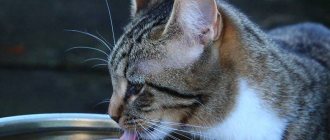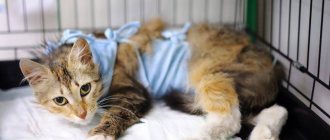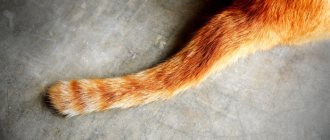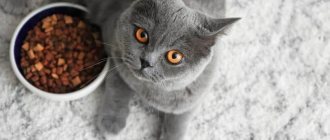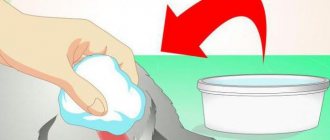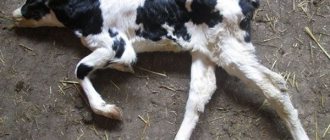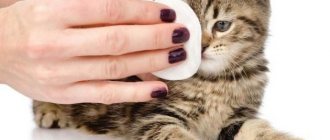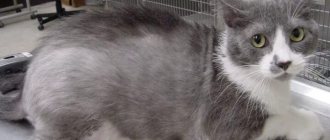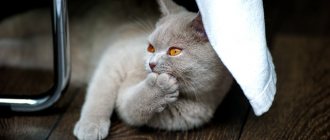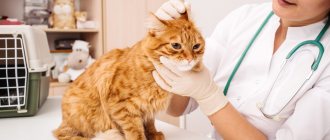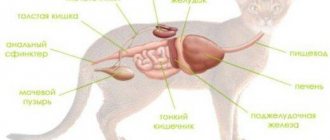If the owners discover a fat tail on a cat, then it is worth taking the pet to the veterinarian, since such a symptom may indicate serious illnesses. Often the reason why the fur in this area becomes oily lies in inflamed internal organs or insufficient intake of vitamins and minerals into the cat’s body. In addition to a fat tail, the cat may be bothered by pain, and there may be an ulcer from which black exudate or pus is released.
What caused the violation: the main reasons
Veterinarians are inclined to believe that the main source of the problem in cats is impaired function of the sebaceous glands; this is due to the influence of external and internal factors.
With various pathological changes in the organs, different formations are possible on the skin of the cat’s tail, which are brown or black. When a pet’s skin rots and the coat becomes oily, this may signal the following internal problems:
- Inflammation of the paraanal glands. The structures provide the animal with a painless process of bowel movement, and if their function is impaired, tail fat and other unpleasant symptoms are likely.
- Infection. Skin irritation is a consequence of the active proliferation of pathogenic microorganisms. In this case, a wound appears that rots and emits a bad smell.
- Disturbed balance of hormones. Such failures occur more often in cats that have not been sterilized.
It is difficult for an overweight animal to care for this part of the body, which is why this symptom appears.
A cat's greasy tail does not always require serious treatment; sometimes it is enough to make adjustments to the pet's lifestyle. Sometimes a plaque that appears on the skin in this area occurs due to an unbalanced diet of a pet. The problem often affects individuals who are fed low-quality foods or eat a lot of fried and spicy foods, which causes the sebaceous glands to work more intensely. Also, a greasy and dirty tail is a consequence of insufficient hygiene. Overweight cats are more susceptible to this disorder because they are unable to clean their tail on their own. If the owners do not notice the problem in time, then wounds may appear and suppurate.
Additional symptoms
When dirty fur is observed at the base of the cat's tail or it becomes greasy, it is worth taking your pet to the veterinarian in order to diagnose the problem in time and avoid unpleasant consequences. If dirty skin and coat are associated with pathology, then the following additional symptoms may be recorded in the pet:
The animal may have a bald patch in the problem area.
- tuberosity and peeling of damaged epithelium;
- the appearance of a thin crust on the tail, which consists of purulent fluid;
- pathological shine of the fur in the area where it joins the body;
- discharge that cannot be washed off with hygiene products;
- scratching and red rashes;
- severe itching;
- pain syndrome;
- hair loss on the tail;
- inflammatory reaction in the anal area.
As the disease progresses, the owner may notice a brown spot on the cat, which festers and can subsequently lead to infection and complications.
Symptoms of the disease
It is believed that cats are more susceptible to this disease than others, but it can also occur in cats. Moreover, some breeds are more at risk than others of developing such an unpleasant and difficult-to-treat disease. For example, the Scottish Fold cat is often noted to have a hard tail, while according to breed standards its mobility is especially valued. With such a disorder, a “greasy tail” may also occur.
But the Persian cat is more susceptible to acne, which causes her not just discomfort, but can cause a serious illness. In addition, representatives of any breed, and even outbred cats, can have a fat tail.
In short-haired or “hairless” breeds, it is much easier to detect such a defect, but it is much more difficult to detect it in an animal with a luxurious, bushy tail. Most often, it is discovered by chance, when the process has already started and done its dirty deed.
Greasy tail syndrome is accompanied by the following symptoms:
- The fur at the base of the tail becomes very greasy, covered with thick secretions, which are very difficult or impossible to wash off using simple methods, at least from the first approach.
- On the skin at the base of the hairs you can see tubercles, which can be inflamed, covered with rough scales, and a purulent crust.
- When the disease is advanced, a whole scattering of inflamed pimples or scars from scratching may be found on the skin.
- When the fur suffers from greasy hair, it can break off at the base, leaving the affected area exposed or looking as if the hair has been clipped or pulled out.
- When the anal glands are inflamed, the animal tries to get rid of their excess contents by crawling with its backside on the floor, and sometimes on the carpet.
- With acne, a greasy yellowish spot first appears on a cat's fur, then a “black dot”, and in the absence of care and treatment, a hard crust forms, under which there may be an inflamed or abscessing acne.
INTERESTING TO KNOW: Diagnosis and treatment of discopathy in cats
Having discovered such symptoms in their pet, the owner needs to contact a veterinarian, who will make a diagnosis and tell you how to deal with the disease.
Diagnostics: how is it carried out?
To decide on treatment tactics, the doctor must examine the animal’s sore spot.
A wet and greasy area on the tail that appears on a cat requires urgent contact with a veterinary clinic. The specialist examines the problem area and assesses the severity of the violation. In most cases, a diagnosis can be made and treatment can be selected after a visual examination and medical history. If this is not enough for the veterinarian, then laboratory and instrumental examinations are carried out, after which the doctor will tell you how and with what to treat the cat so that the tail becomes normal again.
Systemic treatment
Although the “greasy tail” in itself does not threaten the life and health of the pet, it is a reason to consult a veterinarian. It is necessary to identify the cause, depending on which treatment is prescribed:
- If the cat is intact, there is a high probability that the problem will disappear after castration.
- If the animal is of breeding value, but does not receive the highest points at the exhibition due to the poor quality of the coat and skin, hormonal drugs are used that temporarily suppress reproductive function (Suprelorin).
A dermatologist must be competent in issues of endocrinology. There are hormones that provoke excessive formation of sebum - these are not only sex hormones (androgens, progesterone), but also hormones of the adrenal cortex and adrenocorticotropic hormone of the pituitary gland. Estrogens suppress sebum production.
- Systemic diseases are excluded, especially those related to digestion and metabolism - for this it is useful to take a detailed biochemical blood test.
- The doctor analyzes the cat’s diet; some animals need diet correction. This includes the selection of low-fat feeds, the introduction of food additives that normalize the condition of the skin (contain B vitamins, zinc, sulfur, Omega-3 fatty acids). For obese animals, a weight loss plan is drawn up with mandatory weight monitoring twice a month.
For severe inflammation of the skin and deep comedones, the veterinarian may prescribe a course of antibiotics and anti-inflammatory hormonal drugs. But such measures are needed only when the problem is advanced; in general, the treatment of sebaceous tail comes down to regular local treatments.
Treatment: basic methods
Medications
A kitten's oily fur requires an individual therapeutic approach, which is selected by a veterinarian after a comprehensive examination and clarification of the cause of the disorder. Various medications are used to remove sebum. If the pathology is associated with an infectious focus or other diseases, then the underlying pathology is treated. Antiseptics are used to treat problem areas. The main local medicine is Chlorhexidine, which is used three times a day. A cat's greasy tail can also be wiped with hydrogen peroxide. Also, if there is a problem, other veterinary remedies presented in the table are used.
| Medication group | Name |
| Antibiotics | "Amoxisan" |
| "Vetalgin" | |
| "Oflosan" | |
| "Tsiprovet" | |
| Shampoos with keratolytic effects | "Lactaderm" |
| "Peroxiderm" | |
| "Doctor Zoo" | |
| Topical glucocorticoids | "Kortavance" |
Sometimes soaping an animal's tail once may not be enough.
Antibacterial drugs are used with caution, since oily hair on the tail will worsen even more and dangerous consequences will arise, including deviations from the gastrointestinal tract. When using shampoos, you need to rinse the fatty tail several times, and sometimes the manipulation needs to be repeated 2 times a day.
Treatment with folk remedies
When a cat has shiny fur and a sore tail, you can use natural ingredients. Dirt and grease can be washed off with the help of decoctions, tinctures and other folk medicines that can be made at home. According to practicing dermatovenereologist V.V. Makarchuk, it is better to use sunflower, castor oil, iodine and other products in the form of compresses that are applied to the damaged tail for 6 hours or more.
The cat has a fat tail. What to do?
I noticed that my cat Buttercup's tail became very greasy at the base, as if it was smeared with oil or lard. Buttercup is a long-haired and fluffy cat. Therefore, this change immediately caught my eye: the previously beautiful tail turned into a “fat” icicle. I tried to wash it, but it seems to me that nothing has changed dramatically. Maybe he climbed somewhere and got dirty? Or is this a sign of illness?
Inna
Most likely, our reader’s cat is young, not yet neutered, and he has a phenomenon called “greasy tail” or “manufacturer’s tail.”
The veterinary literature reports that the exact causes of this seborrheic condition in cats have not yet been fully identified (unlike dogs, where a direct hormonal relationship has been established), since the sources record such cases not only in uncastrated cats, but also , although extremely rare, the same in cats and castrated cats.
However, based on my own experience, in the vast majority of cases, this condition is still characteristic of uncastrated young cats, not without reason receiving one of the telling names “manufacturer’s tail,” since young cats may experience a certain hormonal imbalance, as in adolescents, when hormonal levels are still unstable. Therefore, in practice, this problem concerns specifically sexually mature males, and moreover, we can say that a greasy tail is the “privilege” of exclusively uncastrated cats.
What happens and why exactly does the tail become so fat?
The thing is that there is a gland in the tail area. The gland in the tail area is located along its upper surface and consists of many glands, including sebaceous ones.
It is the increased activity or hyperplasia of the glands in the tail area, located along its upper surface, that leads to the release and accumulation of excess secretion on the surface of the skin, as a result of which the tail looks very oily and greasy.
Is “manufacturer’s tail” dangerous and does something need to be done?
Although, in essence, this aesthetic problem for the owner does not cause any discomfort to the cat himself, it is worth paying attention to it and here’s why. Abundant sebaceous discharge from the glands is not dangerous in itself, but it is dangerous due to the development of a bacterial infection. Often the glands become inflamed, irritation occurs under the greasy coat, which can cause the development of bacterial folliculitis and furunculosis, and abscesses. Crusts may form on the tail, the fur may become thinner, and the skin may darken. There may even be hair loss or clumps of hair. Pyoderma develops, a bacterial infection of the surface layers of the skin and hair follicles.
At the same time, the cat is in pain. Therefore, he does not allow his tail to be touched, his behavior changes: the once peace-loving and kindest cat suddenly shows aggression when the owner runs along his tail.
Therefore, if you notice a problem such as a “greasy tail” in your cat, periodically inspect it carefully. It is worth paying attention to the entire tail and the condition of the skin under the fur, regularly checking for inflammation. If inflamed areas are found under the fur, you must not forget to treat them.
If your cat’s “greasy tail” has led to a bacterial infection, you should definitely contact your veterinarian to prescribe appropriate treatment: as a rule, we are talking about the use of antibiotics and antiseptics.
And, of course, it is better to avoid such complications. And take preventative measures.
If you notice your cat has a fat tail, you need to regularly tidy it up and not let the problem get worse in order to prevent the development of a bacterial infection and complications.
However, this is not as simple a task as it might seem at first glance. Anyone who has tried to do this will understand me. At some point it may even seem impossible. Therefore, a few tips from the experience of breeders will be very helpful:
1. Treatment with alcohol, in particular salicylic alcohol, for which there is a lot of advice on the Internet, is not recommended, since salicylic alcohol is very drying and as a result, on the contrary, can lead to the opposite effect - the activity of the sebaceous glands will only intensify, and so the fatty tail will become even more fatter.
2. To clean up the mess, some breeders recommend using hand cleaners, which are sold in hardware and automotive stores, as well as high-quality dishwashing detergents - in which you can try to “soak” the cat’s tail: apply the product to the oily area of the tail, wait a little, rinse water and then wash with cat shampoo. These manipulations, if necessary, are repeated several times.
3. The modern pet industry does not stand still, and a huge range of special professional cosmetics for grooming cats is now available, many of which are worthy of attention and are actually extremely effective in solving various problems.
A number of brands offer degreasing shampoos and degreasing pastes that have proven themselves to be excellent. Also receiving positive reviews are products for washing without water (shampoos, powders, sprays).
Experienced felinologists recommend the following sequence of actions:
Apply dry shampoo or powder generously to the oily area of the tail;
comb out the powder thoroughly;
repeat several times.
This procedure can be carried out every day.
After such manipulations, if necessary, you can wash the cat (however, you should not wash it every day). It has been noted that after such treatment with dry shampoo or powder, the fatty tail is washed off much better.
By the way, instead of powder or dry shampoo, some breeders recommend using ordinary potato starch as a folk remedy. Starch is used similarly to dry shampoo: apply generously, comb out well, and if necessary, wash the animal afterwards.
4. You should not be overly zealous and with manic persistence try different means on your cat’s tail: constantly wash, rub, dry with alcohol, and so on in a circle. Such activity of the owner, on the contrary, can only aggravate the situation: the skin of the tail will become dry, while the fat content will not decrease and the fat secretion will become even more intense. And if inflammation has already occurred, it should be treated with mild means so as not to cause an exacerbation.
5. And, of course, the most effective and radical remedy is castration of the cat. If the cat is not used as a breeding stock and does not participate in breeding, I strongly recommend that you contact a veterinarian and have your pet neutered.
In addition to the fact that castration will help solve the problem of “greasy tail” and bring the cat back to normal, it will have a positive effect on the cat’s behavior and will remove a possible marking problem in the future or existing in the present and will protect the house and your property from manifestations of the pet’s sexual desire. After the operation, the cat will become more affectionate, playful and affectionate.
Irina Kostyuchenko, felinologist
If you have questions about keeping, feeding cats, as well as suggestions, send them to the editor or to my email address HYPERLINK “mailto: Email address is being protected from spambots.
Javascript must be enabled in your browser to view the address." The email address is protected from spambots.
Javascript must be enabled in your browser to view the address. Answers to the most interesting questions will be published on the pages of the magazine
Local treatment
Washing sticky brown discharge from skin and fur is truly difficult. It is necessary to choose a shampoo with anti-inflammatory and keratolytic effects. There is no need to wash the whole cat; only problem areas are treated.
For greasy tail, the following are recommended:
- Zoohygienic shampoo "Doctor". Treatment begins with daily treatments, and contact of the foam with the skin should be at least 5-7 minutes. Then the tail is washed at intervals of 1-3 days until the skin is in satisfactory condition. For dark-colored show animals, keep in mind that shampoo may lighten the fur slightly.
- Shampoos with chlorhexidine 4% (Global Vet, Doctor VIC, Api-San). This detergent is prescribed for severe pyoderma. The shampoo will effectively destroy pathogenic fungi and bacteria and relieve inflammation. It is necessary to keep the foam for 5-10 minutes, the treatments are repeated after 3-5 days for a month.
- Specialized products for very oily coats. Before the show, you can use deep cleansing shampoos such as Jerob One-Step Grease Removing (USA, An-Ju). Apply the product to wet fur, after 3 minutes foam with water and rinse thoroughly.
Many breeders use regular Fairy type dishwashing detergent for pre-show preparation. They do indeed completely remove oil, but are not safe in the long term because they disrupt the pH of the skin and dry it out.
After washing, the final rinse can be carried out with herbal infusions and decoctions - chamomile, calendula.
Ointments with antifungal, antibacterial effects, as well as hormonal ointments can only be used as prescribed by a dermatologist. When using such products, the cat must wear an “Elizabethan” protective collar to prevent licking and swallowing of the medicine. To have an effective effect on the skin, the hair (if it has not fallen out previously) must be cut short.
After the course of treatment, excess sebum can be removed using dry powder shampoos, because cats hate washing. Use:
- Trixie Trocken Shampoo;
- Beaphar Grooming Powder;
- Croci Gills;
- regular starch, baby powder.
The powder is applied against the grain, rubbing gently. Then you need to comb it thoroughly using a natural bristle brush.
Why is this happening?
Among the causes of baldness are:
- Lichen. Typical signs of lichen: peeling of the tail, parts of the hind legs, back and ears. An accurate diagnosis can only be made in laboratory conditions. The affected areas are illuminated with a Wood's lamp. If the fur takes on a greenish tint, treatment for shingles infection is prescribed.
- Hormonal imbalances. The cat's body secretes a special substance from the upper part of the tail. The pet distributes lubricant throughout the body while washing. Too active secretion leads to the fact that the tail peels off and becomes fat.
- Ticks and fleas. Even a domestic cat can become infected with fleas. Ticks are brought in from the street by other residents of the house. The area of the mane and tail is a favorite place for parasites, after which the cat begins to constantly itch and literally tear out the fur.
- Infection with helminths. These are parasites that form in the body. Helminths are transmitted through raw fish and meat. This leads to the cat having a loose tail, and worms become a related problem.
- Bacteria. Typical for cats that periodically go outside. Untreated wounds on the tail are a target for bacteria, which can lead to critical infection and a threat to life.
- Allergy. If your cat's tail is going bald, it could be a response to an allergy. Among the reasons: poor nutrition, cheap food, intoxication with medications. In addition, some cats react painfully to odors, particularly tobacco smoke.
- Stress. As in the case of the appearance of worms, the tail peels off during strong emotional experiences. In older cats, this is a consequence of the appearance of a new pet - a dog or kitten. In young furry animals, stress manifests itself after major home renovations, childbirth, or moving to a new place.
- Inflammation of the glands of the paraanal type. The animal begins to urinate past the tray, and the fact of irritation is confirmed by a shaking tail, which gradually becomes greasy, peels off and loses its fur.
Causes
Disease on a pet's tail can occur for various reasons. Often these are: long-standing injuries, severe bruises, wounds, fractures or any other damage. Sometimes, but there are still diseases that are quite difficult to determine. These include: tumors, unknown neoplasms, eczema, osteomyelitis. Any of them requires high-quality qualified treatment in compliance with all requirements and recommendations of a veterinarian. Every loving owner should know why such diseases occur and how to deal with them.
© shutterstock
Greasy tail in a cat: how to diagnose
Although the symptoms of this disease are quite characteristic, and an experienced doctor does not raise doubts, it is often necessary to exclude the possibility of developing other diseases - lichen, neoplasms, skin mites.
This photo shows a cat's greasy tail. As you can see, the picture is very specific.
A veterinarian can make an accurate, 100% diagnosis only after a biopsy—taking a tiny piece of tissue for further examination under a microscope.
Diagnosis and treatment
After discovering lost hair, it is necessary to urgently show your pet to a veterinarian, since at home there is no way to understand the cause of the disease. To make a diagnosis, the veterinarian will carry out the following procedures: collect anamnesis (interview the owner about past diseases, nutrition); conduct an external examination for the presence of characteristic symptoms; will take blood and skin scrapings for study. If necessary, ultrasound diagnostics are performed. After determining the cause of alopecia, the doctor prescribes treatment recommendations:
- Fleas. Elimination of parasites is carried out using shampoos (Fitoelita, Lugovoy, Celandine), drops on the withers (Stronghold, Advocate, Bars), sprays (Delix, Frontline). For prevention, it is recommended to wear a flea collar.
- Lichen. Treatment is usually local - shampoos (Doctor, Alezan, Antifungal), ointments (Yam, Sanderm), Fungin is effective. Vaccines are common for treatment and prevention - Polivac, Vakderm.
- Avitaminosis. If the animal is fed natural products, it is recommended to add a vitamin complex. It is better to give pregnant cats special food designed for this condition. Sometimes doctors prescribe sulfur preparations and immunostimulants.
- Hormonal imbalances, dermatitis, stress - specific treatment depending on the identified problem.
- Inflammation of the paraanal glands. Treatment – massaging the anus area from the outside or inside, treatment with an antiseptic through a catheter. If necessary, antibiotics and rectal suppositories are prescribed to relieve inflammation.
- Allergy. The irritant is eliminated and antihistamines are given.
We suggest that you familiarize yourself with the Siamese cat description of the breed and character.
If a cat’s tail comes off, then the best method of preventing this symptom is prevention. It is enough to provide adequate feeding and care, regular examinations and monitoring of the pet’s condition.
